According to State of Global Air data, around 572,000 neonatal deaths in 2021 were linked to air pollution. They stated that “72% of this burden was due to exposure to household air pollution.” It is becoming an urgent public health issue because of the consequences. Expecting mothers’ exposure to other pollutants linked to increasing infant mortality cases. It happens due to the prenatal exposure to the air pollution.
Additionally, air pollution poses a major concerns with the pregnant woman’s health than any other person. Because the pregnant woman inhales more air in one minute, it causes more air pollution to pass the airways. These pollutants reach to the fetus and can affect the baby. Moreover, air pollution causes many problems to the expected mother. And long-term exposure to air pollution can exacerbate the effects as well. The below image highlights the air pollution impacts on pregnant women:
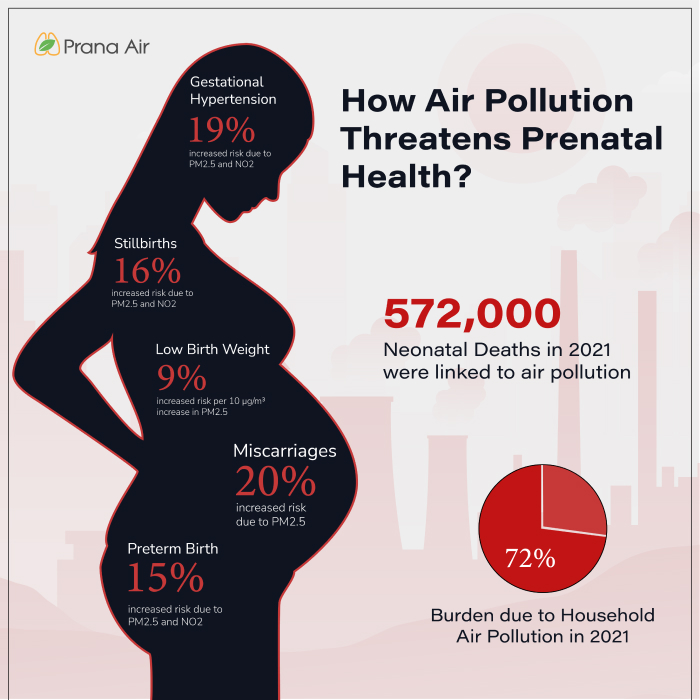
This blog aims to shed light on the air pollution impacts on prenatal health. Prenatal exposure to air pollution is a serious concern. Thus, you can learn ways to mitigate the pollution sources to address prenatal health issues.
Are you aware that air pollution poses significant dangers to pregnant women and newborns?
Air pollution is composed of many pollutants including Particulate matter (PM) and many other gases such as nitrogen dioxide (NO2), sulfur dioxide (SO2), and ozone (O3).
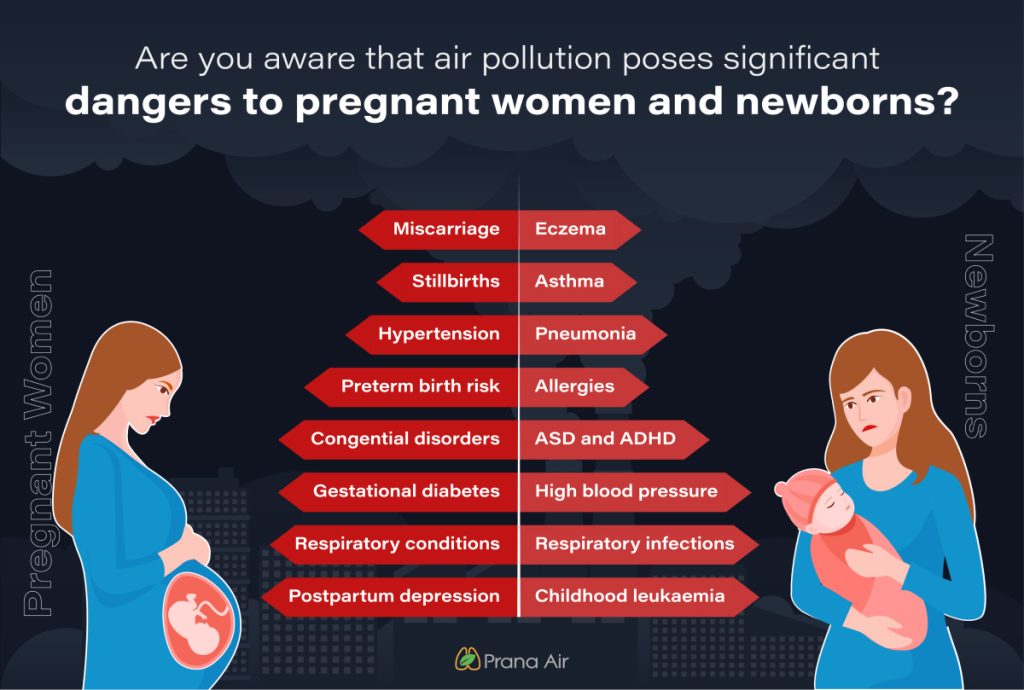
These pollutants correlate to many health issues in infants or new born babies. Such as Pneumonia, Upper respiratory tract infections, High Blood pressure, Childhood leukaemia, Impaired cognitive development altered growth, Asthma, allergies and eczema.
Air pollution exposure during pregnancy can also linked to miscarriage, stillbirths, hypertension, gestational diabetes, congenital disorders, preterm birth risk, respiratory conditions and Postpartum depression.
Household air pollution is significantly responsible for these severe health issues. Because many pollutants are present in the atmosphere. These are also responsible for lower respiratory infections, and other infections diarrheal diseases, brain damage, blood disorders, and jaundice.
“In South Asia and East, West, Central and Southern Africa Air pollution accounts for nearly 30% of all deaths in the first month after birth.” State of Global Air
https://www.stateofglobalair.org/
How Does Prenatal Exposure to Air Pollution Occur?
Pregnant women and newborn babies spend most of their time in the indoor environment. And household air pollution has major role in prenatal exposure. To emphasize, According to WHO data, approximately 2.3 billion people use polluting methods for cooking. With it, many other indoor activities result in air pollution. Additionally, pregnant women inhales more air amount than normal. Hence, it can cause the pollutants to cross placenta and reach to the fetus.
Let us examine the major pollutants’ impacts on prenatal health:
1. Particulate Matter (PM2.5, PM10):
PM2.5 exposure during pregnancy can cause various health risks. Because it increases the oxidative stress and inflammation. A recent study found that the exposure is linked with low birth weight (born too small) and poor fetal growth. As a result, PM2.5 is associated with a 42% infant mortality increase.
2. Nitrogen Dioxide (NO2):
NO2 exposure during pregnancy is significantly risky for infants. Since it is linked to respiratory issues and preterm births. A recent study has found that air pollution exposure leads to 10% of preterm births (born early).
3. Ozone (O3):
Ground-level ozone (O3) exposure to expecting mothers increases many health issues. As it can severely impact the infant’s well-being. The correlation of Ozone exposure linked to increased preterm birth risks and low birth weights. To emphasize, Several studies have found that ozone exposure leads to adverse birth outcomes and leads to infant deaths.
What are the Health Effects of Prenatal Exposure to Air Pollution on new born baby?
Health effects due to air pollution triggered by the mechanism such as oxidative stress and fetal immune system sensitization. It affects the health of the pregnant woman and her expected baby.
Mechanism: Oxidative stress and Fetal immune system sensitization:
The body’s cells use oxygen to create energy. However high exposure to air pollution causes trouble in the process and results in oxidative stress. This results in cell and tissue damage due to oxidative stress. During pregnancy, the fetus develops its immune system to defend against viruses and bacteria. However, air pollution can confuse the learning of the fetus which results in an overly sensitive immune system. It is linked with allergies and asthma-related conditions.
How do these concerns affect infant health?
1. Adverse Birth Outcomes:
Low birth weight and preterm birth: Air pollution increases the chances of low birth weight. Several studies have shown that PM2.5 and PM10 exposure causes it. And low birth weight leads to various other problems. With it, pollutants like nitrogen dioxide and ozone exposure during pregnancy can cause preterm birth.
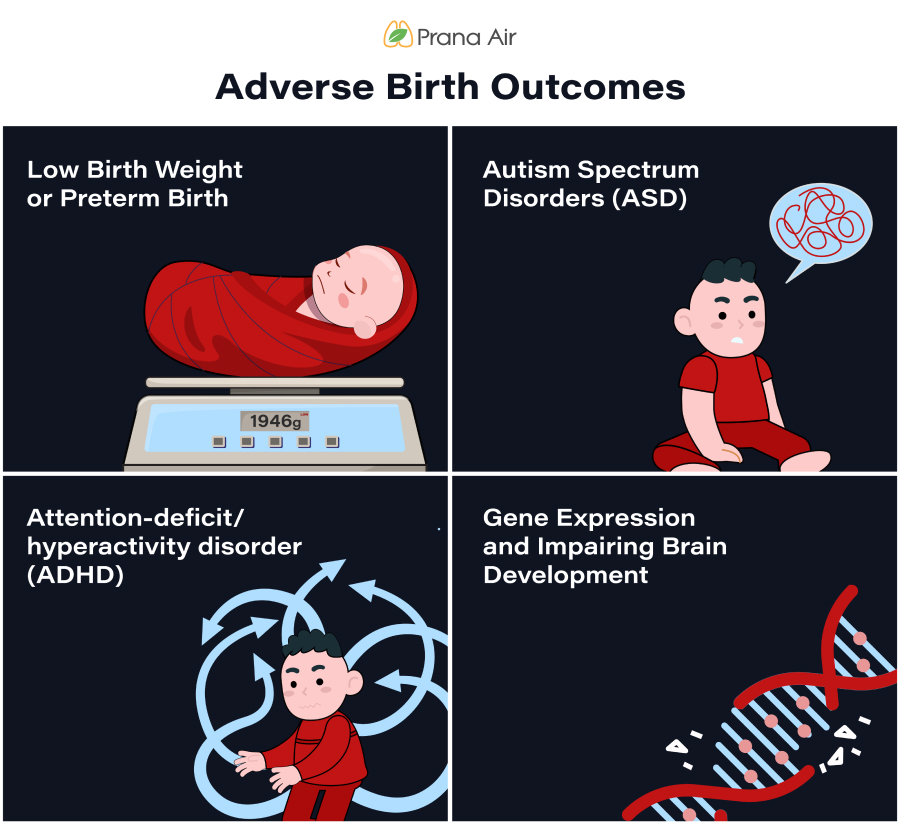
- The major role of these pollutants is to increase oxidative stress and damage the cells and tissues. It impairs the oxygen and nutrient delivery to the fetus.
- Air pollution can also impair or disrupt the brain development. Hence, it results in cognitive deficits including, ADHD (attention-deficit/hyperactivity disorder) and Autism Spectrum Disorders (ASD).
- Moreover, air pollution can alter gene expression but not affect DNA sequence. As a result, impaired brain development and function that can cause cognitive and behavioural issues.
2. Asthma and Respiratory Infections:
Air pollution exposure during pregnancy leads to respiratory issues including bronchitis and asthma in children. PM2.5, PM10, nitrogen dioxide (NO2), and ozone (O3) are the major pollutants. These exposures during pregnancy are related to fetal immune system sensitization. Hence, it results in increasing the chances of developing allergic conditions like asthma.
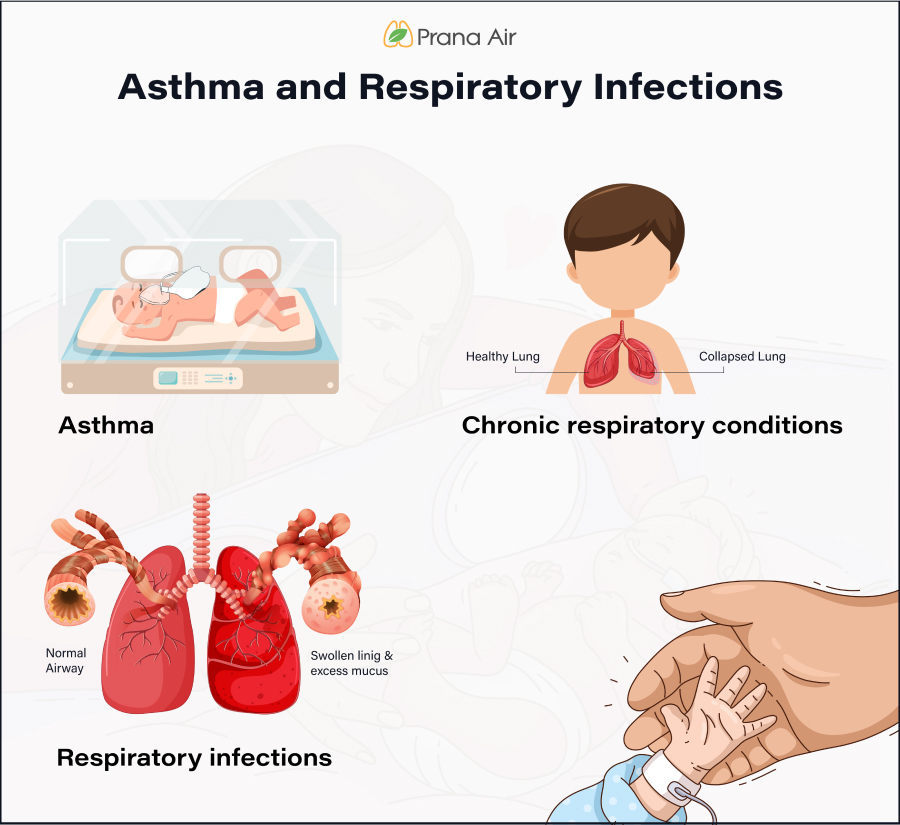
- Moreover, inflammation affects the lungs’ function and development. As it can impair the alveoli and blood vessel formation in the lungs. Hence, it can linked to chronic respiratory conditions.
- PM2.5 results in oxidative stress by reactivating oxygen species that cause inflammation of the respiratory tract. It damages the airways and lung tissues resulting in severe respiratory infections in infants.
- A study confirmed that prenatal NO2 exposure is linked to asthma development in children by the age of 6.
3. Fetal Growth and Development:
Do you know air pollution can cause problems related to improper fetal growth? Air pollution results in high inflammation and oxidative stress. Hence, it can lead to cellular damage to the mother’s body. Since the placental function can be disturbed by the inflammation. As a result, the oxygen and nutrients transferred to the fetus reduce that impaired fetal growth.
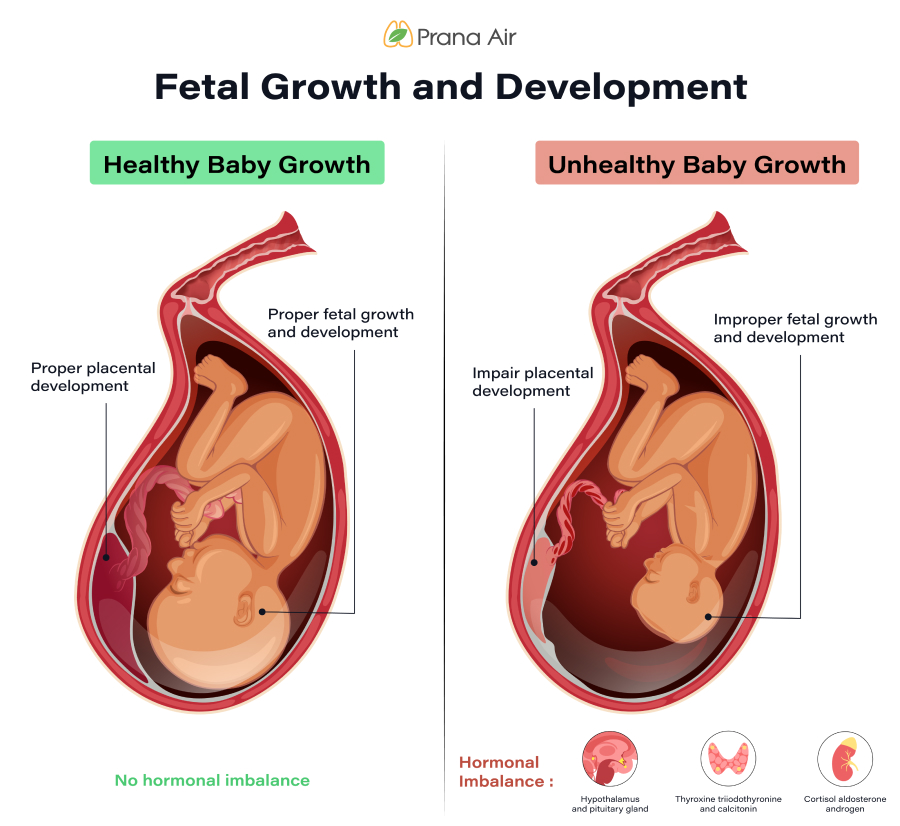
- Air pollution can also impair placental development. It happens when air pollution causes functional and structural changes in the placental cells.
- It resulted in poor oxygen and nutrient delivery to the fetus and caused low birth weight.
- Hormonal imbalance due to air pollution exposure can lead to can interfere with the endocrine system.
How to deal with prenatal exposure to air pollution?
Air pollution during pregnancy can lead to many health issues in infants. Hence effective policies and mitigation strategies are needed. For this, we can aim to reduce emissions from different sources. Besides, we can work on the ground level to save prenatal exposure to air pollution. Thus, air pollution regulations and urban planning are necessary. Since these can address the challenges including prenatal exposure to air pollution. Here are the effective policies and strategies to focus on:

1. Improving air monitoring and reporting:
Enhancing air quality monitoring in the indoor and outdoor atmosphere can help. Through it, pregnant women can take the necessary actions to save themselves from air pollution exposure.
- Opting air quality monitoring devices
- Checking the outdoor air quality index (AQI) on governmental sites
- Timely ensuring public health advisories
- Make the well-informed decision to avoid air pollution exposure during pregnancy.
2. Health advisories and interventions:
Local bodies can educate pregnant women of different societies about air pollution. Since they can emphasize the air pollution health risks that are linked to poor infant health. Also, providing them with guidelines to reduce pollution exposure during peak hours. Hence, it can significantly reduce the adverse outcomes.
3. Investing in air purifiers:
After considering air quality monitors, you can also look for air purifiers. Because clean and fresh air is essential during pregnancy. Hence, the air purifier is the best decision to reduce the pollutants exposure. Since, the air purifier removes toxic pollution, dust etc from the air and provides clean air.
Conclusion:
Prompt attention is needed to reduce the impact of prenatal exposure to air pollution. Since it can affect the health of the pregnant woman and her baby. Thus, urgent action can improve the air quality for pregnant women. It helps in protecting the health of the next generation and provides a healthier environment.







